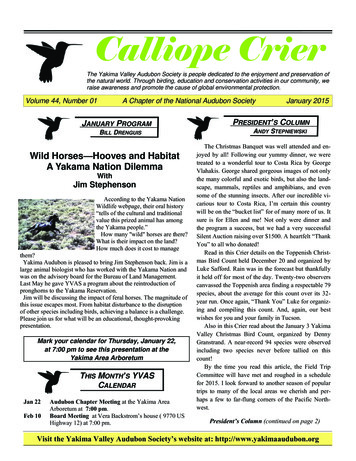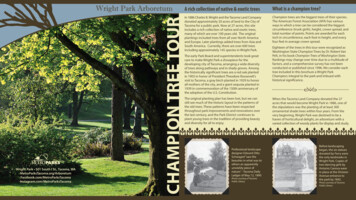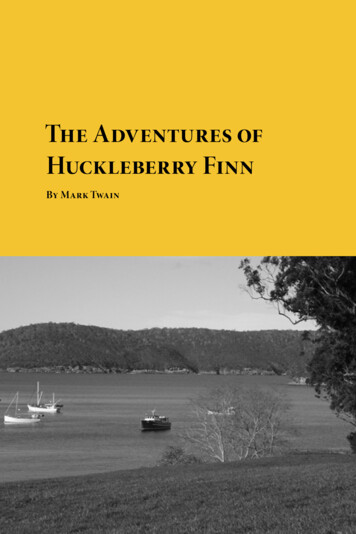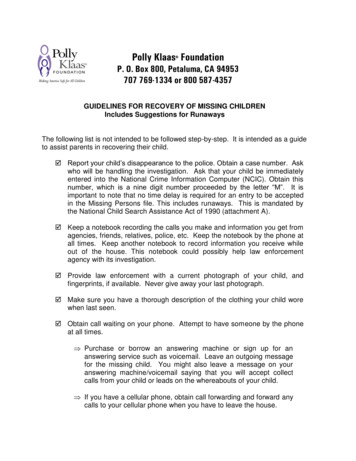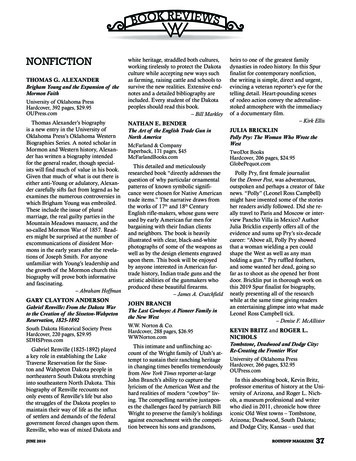
Transcription
MeristemsThe Polly Hill ArboretumWest Tisbury, MassachusettsVol. 17, No. 1, Spring 2015Lilium superbumEducation Center and Botany Lab: A Dream Comes TrueThis February on a lucky Friday the 13th,PHA received amazing news: Our grantapplication to the Massachusetts CulturalCouncil was successful! The Council awarded 200,000 in support of our proposedEducation Center and Botany Lab. Thisfunding, combined with funds from our fallappeal, will be matched by an earlier awardof 500,000 from the Cedar Tree Foundation. In other words: Our dream becomesreality. Construction begins this fall on ournew building.“This new facility is a huge leap forwardfor our education and research programming,” says Executive Director Tim Boland,“and the realization of a longstandingvision.” He adds, “It’s rewarding to knowthat, finally, we’ll have laboratory space andCONTENTSa year-round classroom. We will be reachingmore people than ever before and realizingour mission to a fuller extent.”The new building will replace thestructure called the Gym that is on its waytowards condemnation, but nonethelessserved as inspiration for its replacement,to be built in nearly the same spot. WestTisbury draftsman Peter Rodegast isupdating the original plans created byMargaret Curtin, who will continue herinvolvement with interior design specifications. Tucker Hubbell of Rising SunConstruction will serve as the primarybuilding contractor. Tim adds, “We haveincredible people working on this project;everyone involved cares deeply for theVineyard, the Arboretum, and the spirit1 D R E A M O F E D U C AT O N C E N T E R A N D B O TA N Y L A B C O M E S T R U E2 MESSAGE FROM THE DIRECTORof the place.”The logistics are moving along at aswift pace, however the building projectwill not impact our busy summer season.Construction is scheduled to begin inSeptember, and we expect to be finished byJune of 2016. We will keep you updated aswe move through the season.We heartily thank everyone whodonated to or supported this collaborativeproject. We are thrilled and grateful. It isespecially rewarding as the funds came frommembers, friends, a foundation, and now theCommonwealth of Massachusetts. Whilethe building will offer new possibilities,our summer programs and landscape areever changing. Please plan to join us thisyear at PHA.7 FROM THE LIVING COLLECTION10 F R O M T H E V I N E YA R D F L O R A3 ARBORETUM NEWS11 V O L U N T E E R S I N T H E A R B O R E T U M5 E D U C AT I O N A N D O U T R E A C H12 T H E N A N D N O W
ARBORETUM NEWS3The Polly Hill ArboretumTHE C OR POR AT I O N A N DBOAR D OF DIR E CT O RSRachel Smith AlternativeTimothy M. BolandEx OfficioPrentice BowsherSarah GriffinPamela KohlbergIya LabunkaGary MontrowlHunter MoormanRichard M. ReischeClaire SawyersE. Douglas SederholmLydia Hill SlabyTreasurerJoan Margot SmithPresident & ChairmanSusan H. WassermanSecretaryHO N OR AR Y B OA RD ME M BE R SRobert W. DoranLisina M. HochPhilippe de SpoelberchStephen A. SpongbergRESE AR C H A SSO CI AT E SMelissa CullinaDavid R. FosterMatthew LobdellGregory PalermoSTAF F OF T HEPOLLY HIL L A R B O R E T UMTimothy M. BolandExecutive DirectorJill BouckYouth Education CoordinatorTom ClarkCuratorBarbara ConroyAdministrative &Financial OfficerBetsy DrippsYouth Education CoordinatorErin HepfnerVisitor Services/Resource SpecialistIan JochemsHorticulturist/ArboristBen MadeirasHorticulturistKarin StanleyEducation, Membership &Outreach CoordinatorThe mission of the Polly HillArboretum is to perpetuatethe experimental tradition inhorticulture established byPolly Hill by sharing knowledgeof plants and scientific procedurethrough educational programs,research, plant conservation,and exploration. The Arboretumseeks to preserve its meadowsand woodlands, to promote anunderstanding of its collections,and to encourage their utilizationfor scholarship, observation,and the enjoyment of all.Meristems The Newsletterof the Polly Hill ArboretumNews & Photography PHA StaffEditor Laura CoitDesign Lorraine FergusonPrinting Bolger, Minneapolis MNPrinted on recycled paper.Arboretum StaffFront row, from left: Ian Jochems, Erin Hepfner, Tom Clark, Betsy DrippsBack row, from left: Tim Boland, Karin Stanley, Barbara Conroy, Jill Bouck, Ben MadeirasPhoto: Kathy KinsmanMessage from the DirectorIt is safe to say we are all looking forward to summer!The intensity of our winter storms combined withthe persistent snow had me craving green relief. As Iwrite this the carmine buds of our Accolade cherriesare poised to burst into glorious pink bloom. Springis finally here!The first warm days found the greenhouse andlandscape alive with activity. We welcomed backseveral volunteers who had either been away orwere waiting for warmer temperatures to end theirhibernation. On the grounds, after assessing andcaring for plants that experienced winter damage,we are now busy planting new plants, several nevergrown here before—horticultural experiments.While snow was still on the ground TomClark and Ian Jochems installed an outdoor exhibit,Vanishing Acts: Trees Under Threat, that tells thestory of how our favorite trees are facing challenges,locally, regionally, and on a global scale. Global treeconservation is part of our mission at PHA. We aretaking action to find solutions.On our seed expedition to the Ozarks this fall,we collected seed of the critically endangered maple-leaf oak (Quercus acerifolia). I am happy to report aseedling has sprouted in the greenhouse! This is thebeginning of a new addition to our landscape. It willjoin other trees in our collections that are strugglingto persist in their native habitat. Arboreta around theworld are intent on telling the stories of trees andinstilling a sense of stewardship to ensure their future.We have produced an ample crop of otherseedlings. I spent some uplifting momentstransplanting the vernal witch-hazel that sprouted inabundance from our Ozark expedition last fall. It’sexciting to imagine a future where these shrubs lightup our winter days with beautiful flowers—just oneamazing attribute of this often overlooked NorthAmerican native shrub.Please plan to visit your favorite local Arboretumthis summer, and if you have the interest and time,consider becoming a volunteer. We look forward toseeing you!WelcomeSummer InternsWelcomeTory StewartGood Newsfor AmandaPHA’s educational program is a fundamental component of our mission. Studentinternships have been an integral part ofthat program since our founding in 1998.Then, as now, our summer internships havebeen funded by the Feldman family. Weare exceedingly grateful for this enduringsupport that has benefited both PHA andthe interns, and furthered the horticulturalcareers of so many students.This year we welcome Jayne BoccellaPerras and Abby Makowski to that rosterof student interns. Both are majoring inhorticulture: Jayne will be a senior at TempleUniversity this fall, and Abby, a junior, atMichigan State University. To say they areenthusiastic about spending a summer atPHA would be an understatement!Jayne was attracted to PHA not justbecause of its location, but by Polly Hill’sinspiring philosophy. Abby plans to pursuea career in public horticulture and feels theinternship is a pivotal step in that direction.We do too! We are thrilled to have thechance to mentor, share, and further inspireJayne and Abby. We hope you get a chanceto meet both of these exceptional students.Join us in welcoming Connecticut Collegegraduate Victoria (Tory) Stewart as our2015 collections management intern.With the ink barely dry on her Bachelorof Arts diploma in botany, Tory arrivedJune 1 to begin her 9-month internship.In addition to her studies, Toryhas worked as curatorial/field assistant atthe University of California Davis Centerfor Plant Diversity where she mappedand surveyed native plants and workedin the herbarium. She was also a summerintern at the Arnold Arboretum inBoston. The Arnold provided handson horticultural experience, exposureto collections curation, and the chanceto visit PHA where she learned of ourinternship program. Lucky for us!As a PHA collections managementintern she will gain a wide range ofexperiences and pursue her interests inhorticulture, botany, and sustainability.We suspect she will develop a naturalaffection for her namesake tree, stewartia—a tree dear to our hearts. Welcome toTory Stewart!Amanda Wilkins, 2014 PHA collectionsmanagement intern, was accepted to theUniversity of Edinburgh’s master’s programin biodiversity and taxonomy of plants.We congratulate her on acceptance to thisprestigious institution!ArboretumWish ListHerbarium Specimen Framing 300In an effort to strengthen interpretationin the Visitor Center, we would liketo display three framed herbariumspecimens behind the desk. The cost offraming all three would be 300.If you would like to contribute toour wish list, please call Barbara Conroyor Tim Boland at 508-693-9426. Weextend our gratitude to those of youwho have responded to our previousrequests.Staff NewsIn early March, Tim Boland and hiswife, Laura Coit, attended the AmericanPublic Garden Association’s Native PlantSymposium at the Lady Bird JohnsonWildflower Center in Austin, Texas. Timgave a presentation on PHA’s native plantproduction program, MV Wildtype, andwas the moderator for a discussion panel,“Defining Native?” In April, Tim travelledto the Scott Arboretum in Swarthmore,Pennsylvania, to present a lecture titled“In Search of Wild Seed.”Closer to home, Tim participated ina series of landscape talks in collaborationwith the West Tisbury Library. The seriesincluded “Healing Fragmented Landscapeswith Native Plants” and “Trees Are theAnswer! Cultivating Trees on Martha’sVineyard.” Additional lectures included“Small Flowering Trees for Landscapes”and “Plants of the West Tisbury LibraryLandscape,” which included a tour of thelandscape that was designed in consultationwith PHA and features plants producedfrom our nursery facility.In celebration of the 45th anniversaryof Earth Day in April, the Martha’sVineyard Film Center screened threedocumentary films produced by Vineyardfilmmakers Liz Witham and KenWentworth of Film-Truth Productions.Tim, Tom Clark, and Ian Jochems tookpart in a panel discussion after the screening of The Story of Seeds, a portion ofwhich featured PHA’s MV Wildtype.
4 – ARBORETUM NEWSE D U C AT I O N A N D O U T R E A C HNew Horticulturist Starts PlantingFamily Programs“I can’t believe I get to work here!” is asentiment Ben Madeiras has shared morethan once since beginning employment asthe Arboretum’s new full-time GroundsHorticulturist. At the Arboretum we all canrelate to this feeling as spring’s arrival makesPHA the world’s most beautiful workplace.Since his first day Ben has been contributing in a variety of ways, from cleaningup after the long winter, to helping in thegreenhouse, to working with and learningfrom Arborist/Horticulturist Ian Jochems,to enthusiastically stepping in to help withthe youth education program. Each day hehas been assimilating more knowledge aboutPolly Hill, the Arboretum, its plants, ourmission, and the valuable role PHA fills onthe Island and beyond.We’re happy to have Ben here and he’sthrilled to be here. In fact since welcomingBen as PHA Horticulturist, we are reminded daily of our sound decision. “I am soexcited to contribute to the growth andforward movement of this place,” says Ben.Indeed, Ben arrives at PHA at a timewith momentum—important projects, bigFamily Book Seriesand small, abound—all fundamental tofulfilling our mission.Born and raised on Martha’s Vineyard,Ben values what makes the Vineyardcommunity unique. Involvement withthe horticulture program at the Martha’sVineyard Regional High School fueled Ben’sinterest in plants that soon grew intoa full-fledged career. He acquired experiencein residential horticulture through positionsof increasing responsibility with variouslandscape companies. And as his interest inplants and landscapes grew, PHA becameone of his favorite places on the Island.Ben pursued his plant passionbeyond high school graduating with anAssociate of Science degree in landscapecontracting from the Stockbridge Schoolof Agriculture. He went on to earn a BS inlandscape architecture from the Universityof Massachusetts Amherst graduating cumlaude in 2012. Informed by his formaleducation and grounded by his Islandupbringing, Ben explains in his application,“I want to work in a place where I canparticipate in the betterment of the Island’sBen MadeirasPhoto: Kathy Kinsmanenvironment and community.” PHA issuch a place.A milestone in an Arboretum careeris your first tree planting. For Ben it was aSerbian spruce planted as part of our ArborDay celebration. By the time you readthis article, he’ll have planted many more.Please take a moment to meet Ben andwelcome him to our staff on your next visit.Spring CelebrationIn the midst of this particularly snowy andcold winter at the Arboretum, we pinedfor that sure harbinger of spring on theVineyard: daffodils. Their sunny bloomscomplete the perfect pastoral scene at everyturn on the Arboretum grounds, and allover the Island. What better way to celebratea well-earned spring than to invite familiesVases of daffodils displaying 39 different varieties filled the Far Barnto PHA for a celebration?At the event, daffodils from Islandgardens lined the steps to the Far Barninviting guests to an informal flower show.Inside 39 different labeled cultivars ofdaffodils, provided by the daffodil expertsat Brent and Becky’s Bulbs, were displayedin Mason jars. Visitors were encouraged tovote for their favorite. Later the results wereshared on Facebook. In addition, a volunteerled arts and crafts for children of all ages—an elderly gentleman even made a paperdaffodil for his wife! The staff-led tour ofspring flowering plants was so popular,a second one was offered following the completion of the first!During a time of year that is otherwisequiet, it was heart-warming to see so manyfamilies enjoying the Arboretum on an earlyApril weekend. Look for another springcelebration next April, just when you needit most!5Looking for more family activities? Newthis season the Arboretum will offer a freebook series designed for children and theircaregivers. Tuesdays in July and Augustat 10:30 am, nature-based children’sstorybooks will be read aloud, followedby a walk or activity related to the book.Books will be selected for children 3 to8 years old, though all ages are welcome.Bring a small blanket to sit on. Pack apicnic lunch and extend your visit! (Pleasenote: All children must be accompaniedby an adult. In case of rain, we meet in theFar Barn.)And don’t forget our popular . . .Family Backpack TourThe Arboretum is the perfect place forfamilies to discover nature together. OurFamily Backpack Tour makes it easy.These fun and informative educationalbackpacks contain an Arboretum tourand map, field guides, magnifying glasses,sketch pads, and other materials to engagethe entire family in nature study duringtheir visit. Backpacks are available at theVisitor Center between Memorial Dayand Columbus Day from 9:30 am to 3 pm.Island students learn about endangered trees during a visit to our Vanishing Acts exhibit(on view through June 28).Vanishing ActsDeveloped by the Morton Arboretum, thistraveling exhibit (on view through June 28)seeks to increase public awareness of theprecarious future of the world’s endangeredtrees. On a visit to Vanishing Acts, studentsof all ages embark upon a global journeyto explore compelling tree stories fromaround the world. They learn about trees asa resource, why they are threatened intheir native habitat, and how they canbe conserved. Five of the featured trees areplanted on the Arboretum grounds.In addition to our regularly scheduledspring school fieldtrips, several otherclasses have taken advantage of this onetime educational opportunity. Interpretative lesson plans and a teacher guideare available.First Mother’s Day EventIn early May the Accolade cherries bloom,the magnolias break bud, and azaleasare beginning to pop—a lovely settingto honor moms on their special day. Thisyear on Mother’s Day, PHA was openfor picnicking. Many families loungedon blankets among the flowering treesenjoying time together. A 10:30 tour wasoffered (later than usual) to let familiesrelax and take in the beautiful morning.Staff were on hand to take family photosthat were then printed and offered as aMother’s Day gift from the Arboretum.To complete the Mother’s Day package,the Arboretum sold select flowering shrubsand perennials—a welcome present forany mother, or anyone for that matter!
FROM THE LIVING COLLECTION6 – E D U C AT I O N A N D O U T R E A C HSummer Program PreviewMany of our 2015 summer programs willaddress themes related to Vanishing Acts:Trees Under Threat, the travelling exhibitdisplayed at PHA from March throughJune. We will focus on trees, seeds, naturalhistory, plant conservation, and the benefitsof trees to society as well as other topics ofhorticultural and botanical interest.We start in June when Curator TomClark, Executive Director Tim Boland, andHorticulturist/Arborist Ian Jochems sharestories from last year’s collecting trips to theSoutheast and the Ozarks in search of seedof endangered plants (and other plants!).Learn why the Arboretum goes afield tocollect, what seeds were collected, and howthey will add to our collections.In August for the David H. SmithMemorial Lecture, we go further afieldto learn about collecting rose species inAsia. Bill McNamara, executive director ofQuarryhill Botanical Garden, will presenthis expeditions in search of wild rose species.Quarryhill, located in Glen Ellen, California,has one of the largest collections of speciesroses in the world.We also welcome two additionalgarden directors this summer. Ourannual Lisina and Frank W. Hoch lecturefeatures Longwood Gardens’ director, PaulFairy Castles,Forest Creatures &Strolling Minstrels– They’re Back!We are pleased to welcome back potterBill O’Callaghan and storyteller RobinTuck for another version of A Walk throughImagination. This year’s story, “The Peopleof Pim,” will lead you on a tour through themagical landscape at the Arboretum. Alongthe way Bill’s whimsical sculptures tell thetale of a little changeling boy who helps acommunity bring back plant lore and thebelief in fairies with help from the mysticalPeople of Pim. A charming exhibit foryoung and old alike: July 15 to August 31.Sir Peter Crane, Dean of the Yale School of Forestryand Environmental Studies and former directorof The Royal Botanic Gardens, Kew, UK, will sharethe history and botany of the mysterious and ancientginkgo tree on August 19 at 7:30pm.Redman, telling the story of one of theworld’s greatest gardens from its legacy ofhorticultural grandeur to its current focuson research, education, and the arts. AndArnold Arboretum director Ned Friedmanwill explore how Darwin looked to theworld of horticulture to gain insight intohis theory of evolution in “Mutants in ourMidst: Darwin, Horticulture & Evolution.”Additional evening speakers includeAmherst College professor Ted Melilloon biopiracy (the robbery of indigenousenvironmental knowledge and organisms)during the 18th and 19th centuries; TimWood from Spring Meadow Nurseryexplores the world of hydrangeas; and authorRichard Horan shares his quest to link treeswith great writers.We are very pleased to welcome SirPeter Crane, renowned botanist, Dean of theYale School of Forestry and EnvironmentalStudies, and professor of botany. Sir Peterwill share the history and botany of themysterious and ancient ginkgo tree. Don’tmiss this special lecture!For a study of native Island trees,we welcome back Sheriff ’s MeadowFoundation’s director of stewardship KristenFauteux and MV Land Bank ecologistJulie Russell for an in-depth ID workshop.For identification on a smaller scale, joinnaturalist Charley Eiseman for a walk-andtalk as we track the tiny animals covered inhis field guide, Tracks & Signs of Insects andOther Invertebrates.We are excited to offer something newthis summer for families—a family bookseries. Every Tuesday morning in July andAugust a volunteer will share a nature-basedchildren’s book with children and theircaregivers. An Arboretum walk or activityrelated to the book will follow. (See panel onpage 5.)Other special programs include ourannual Martha’s Vineyard garden tour; areturn of Bill O’Callaghan and Robin Tuck’ssculpture and story exhibit, A Walk throughImagination; a pruning workshop; makingherbal salves; our popular drawing fromnature series; and landscape history at PHA.For our complete summer scheduleincluding dates and times, look for oureducation brochure mailing or visit oureducation page at pollyhillarboretum.org. Toreceive email program updates, contact Karinat karin@pollyhillarboretum.org. We thankour friends and sponsors—Bartlett TreeExperts, Donaroma’s Nursery & LandscapeServices, Heather Gardens, MiddletownNursery, and SBS: The Grain Store—fortheir generous support of our lecture series.7Our PlantConservationMissionby Tom ClarkLet’s start with a few facts. First andforemost, plants are not optional; they areessential to life. Period. Second, our planet’swealth of plant diversity is threatened bya litany of challenges nearly all of whichare linked to human activity. Third, botanicgardens and arboreta have a key role to playin plant conservation. And finally, PHA isan arboretum that actively contributes toconservation efforts.Looking at plant conservation froma broad perspective, the number of plantspecies threatened is daunting—anestimated 20 to 25 percent of the worldtotal of nearly 400,000 species. The perilsfaced by different species comprise a matrixof contributing factors, and the political,regulatory, and social context in whichconservation groups are obligated to work iscomplex.It’s hard to imagine that a singleinstitution could tackle this crisis singlehandedly. Enter Botanic Gardens Conservation International (BGCI) to providestrategic guidance and direction. In 1999the concept of an international plantconservation initiative was proposed, andafter years of international collaboration(in 2012), BGCI published The GlobalStrategy for Plant Conservation (GSPC).This document establishes five ambitiousobjectives and 16 specific targets. Hundredsof public gardens around the world havealigned their conservation activities withGSPC, including PHA. GSPC also set abold, imperative deadline—the year 2020.So how does a small arboretum on theisland of Martha’s Vineyard fit into thisbig picture? PHA’s foundation is built onits incredible diversity of plants developedthrough Polly’s philosophy. Our plantSciadopitys verticillataJapanese umbrella-pine is a splendid conifer for Islandlandscapes, but is threatened in the wild.
8 – FROM THE LIVING COLLECTION9Our Plant Conservation Mission, continuedcollections and staff, guided by our missionstatement and leadership, contribute toPHA’s readiness to substantively contributeto meeting certain targets. For exampleTarget 8:Protect at least 75 percent of threatenedspecies in ex situ collections, preferablyin the country of origin, and make at least20 percent available for restoration andrecovery.Ex situ conservation is the conservation andmaintenance of samples of plants outsidetheir natural habitat in the form of wholeplants, seed, pollen, vegetative propagules,tissue or cell cultures. It is the opposite ofin situ conservation, the preservation ofnatural populations inside their native range.For PHA a key aspect of our conservationefforts is focused on the maintenance anddevelopment of ex situ plant collections.But how do we determine which plantsare threatened? Don’t we first need to knowwho’s on first? GSPC Target 2 tackles this.It sets the goal of assessing the conservationstatus of all plant species as they occurin the wild in order to effectively informconservation action. This complicated butessential step results in “Red Lists” whereeach species is categorized in one of sevenranks, ranging from Least Concern toExtinct.As an example, Vineyard native blackoak is of Least Concern according to itsRed List. And although the shadbushes(Amelanchier) have yet to be assessed,our native Nantucket shadbush (A.nantucketensis) will likely fall into one ofthe threatened categories. Several recentRed Lists have detailed the conservationstatus of significant garden plants, includingmagnolias, rhododendrons, oaks, conifers,and maples—all cornerstone genera atPHA. The foundation of these valuablecollections was laid by Polly Hill and she,decades ago, was growing several threatenedspecies in her arboretum, including severalspecies of fir (Abies), Japanese umbrellapine (Sciadopitys verticillata), the exquisiteRhododendron makinoi, and even one thatis extinct in the wild, the Franklin tree(Franklinia alatamaha).Have you wondered about PHA’semphasis on wild-collected seed? Simplyhaving representative specimens ofthreatened species in our collections isimportant, but it’s the provenance of thoseplants that dictates their value. From acuratorial standpoint the most prized plantsRhododendron makinoiThe felted new growth of Rhododendron makinoiextends the season of interest of this deer-resistantfavorite vulnerable in its native Japan.western North Carolina mountains islisted by the Rhododendron Red List asvulnerable. Plants Polly Hill raised fromseed (from her Delaware garden) haveflourished here for decades. Our 50-yearold specimens are gorgeous, but they offerlittle in terms of direct conservation value.That’s why I participated in a collectingtrip last year to secure seed from its nativerange to develop a conservation collectionof this rhododendron species. As a result,hundreds of genetically diverse pinkshellazalea seedlings are in production andin time (some!) will be planted on thegrounds. Others will find their way to peerinstitutions to enrich their collections andhelp secure the future of this species.As PHA continues to evolve we intendto strengthen our relevance to those onthe Island, and beyond, who value our workand who turn to us as a resource. How?By following our mission and continuingto develop a collection of plants thatengages people with the plant world, offersopportunities to educate students, engendersappreciation for the essential role plantsplay in our lives, and meaningfullycontributes to plant conservation. Failureis not an option.are those grown from wild-collected seedfrom well-documented sources in the plant’snative range. Such collections provide thegreatest genetic diversity. This is why PHAregularly leads, or participates in, collectingtrips to various parts of the world, and whywe collect right here on Martha’s Vineyard.For example, pinkshell azalea(Rhododendron vaseyi): this native of theLeft: With continued support from the AmericanRhododendron Society Research Foundation, TomClark will return to the southeast United States tocollect additional rhododendron seed with a specialemphasis on the Oconee azalea, Rhododendronflammeum (pictured left). Tim Boland will join PHAResearch Associate and head of collections andcurator, Matt Lobdell of the Morton Arboretum ina collection trip to South Carolina with a focuson endangered oak species. This collection collaboration and Tom’s return trip supports The GlobalStrategy for Plant Conservation (GSPC).Photo: Rick LewandowskiSeed of the pinkshell azalea, Rhododendron vaseyi,collected by Tom Clark on his 2014 southeasternUnited States trip has germinated in abundance,adding to the conservation value of the PHAcollections.Right: Rhododendron vaseyiNearly 100 species of rhododendrons are cultivatedat PHA, including the vulnerable pinkshell azalea.Franklinia alatamaha. The Franklin tree, a close relative of stewartia, is extinct in the wild but grows at PHA.
1 0 – F R O M T H E V I N E YA R D F L O R A11VOLUNTEERS IN THE ARBORETUMA Tale of Two LiliesSydell Rabinby Erin HepfnerObserving lilies in the wild elicits a feelingof being blessed by nature. That nature canproduce such unique and colorful specimens,diverse yet recognizable, is extraordinary.Of the roughly 100 lily species worldwide,22 are native to North America. Only twoare native to Martha’s Vineyard. Do youknow them?The first native lily, and the more wellknown, is the wood lily (Lilium philadelphicum). Of the native North Americanlilies, the wood lily has the greatest range,extending from New England to thesouthern Appalachians, prairies of theGreat Plains, and meadows of the westernmountains. The wood lily grows in variousopen areas including coastal sandplains—habitats that are rare along the East Coastand a protected ecosystem on Martha’sVineyard. In these dry, sandy, open areas,the wood lily produces its characteristic,show-stopping flowers in shades of vividred-orange.The wood lily is recognized by itsdeep orange 6-petaled flowers (technically3 petals and 3 sepals to be precise) atop asingle stem of whorled leaves. Able to growto 4 feet in some locations, on Martha’sVineyard its height is closer to one foot.Severe deer browse has caused the declineof this species as has the successional growthof meadow into shrubland and forest.The other native lily is the Turk’scap lily (L. superbum). Superb in manyways—graceful stalks, 4 to 8 feet tall, bearpendant orange flowers with recurved petals.Naturally occurring from the southernAppalachians to the Northern AtlanticCoastal Plain, Turk’s-cap lily can be foundmost often, although not exclusively, inthickets, meadows, and open forests withrich, moist soil. Martha’s Vineyard is nearlythe northern point of its range.Despite not being a federally or stateprotected plant, its occurrence has beennoted as rare on Martha’s Vineyard. Its rarityis due, in part, to the lack of ideal habitat—moist, open sites with filtered light. Few siteslike this exist on-Island; streambanks are themost likely location. Similar to the wood lily,deer readily consume the buds of the Turk’scap l
Laura Coit Design. Lorraine Ferguson Printing. Bolger, Minneapolis MN Printed on recycled paper. . Barbara Conroy, Jill Bouck, Ben Madeiras. ARBORETUM NEWS 3. Welcome Summer Interns. Welcome Tory Stewart. Amanda Wilkins, 2014 PHA collections management intern, was accepted to the . University of Edinburgh's master's program in .



